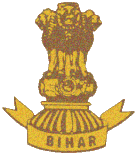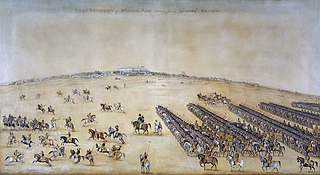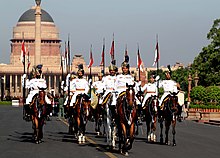
The Governor General's Bodyguard was a cavalry regiment of the British Indian Army and served as the British Indian equivalent to the Household Cavalry of the British Army.

The Sikh Regiment is an infantry regiment of the Indian Army. Sikh regiment is the highest decorated regiment of the Indian Army and in 1979, the 1st battalion was the Commonwealth's most decorated battalion with 245 pre-independence and 82 post-independence gallantry awards, when it was transformed into the 4th battalion, Mechanised Infantry Regiment. The first battalion of the regiment was officially raised just before the partial annexation of the Sikh Empire on 1 August 1846, by the British East India Company. Currently, the Sikh Regimental Centre is located in Ramgarh Cantonment, Jharkhand. The Centre was earlier located in Meerut, Uttar Pradesh.

The Poona Horse is an armoured regiment in the Armoured Corps of the Indian Army. The regiment, known before independence as The Poona Horse, was raised as a regular cavalry regiment in the Bombay Presidency army of the East India Company. It was formed from the 3rd Regiment of Bombay Light Cavalry, raised in 1820, and the Poona Auxiliary Horse, raised about 1817–18. The latter unit was absorbed into the regular forces about 1860 and the two regiments later became the 33rd Queen Victoria's Own Light Cavalry and the 34th Prince Albert Victor's Own Poona Horse.

The Rashtriya Rifles is a counter-insurgency force in India, formed in 1990, to specifically serve in the Jammu and Kashmir region. They also maintain public order by drawing powers from the Armed Forces Special Powers Act, 1990 (AFSPA). The RR was raised by the Indian Army by reconstituting two corps. Its personnel are provided by the Indian Army on deputation. The RR is commanded by an Additional Directorate General of Rashtriya Rifles.

The Bihar Regiment is an Indian Army infantry regiment. It traces its origins back to the British Indian Army. The Bihar Regiment was formed in 1941 by regularising the 11th (Territorial) Battalion, the 19th Hyderabad Regiment, and raising new battalions. The Bihar Regimental Centre (BRC) is located at Danapur Cantonment, Patna, the second oldest cantonment of India. INS Vikramaditya, the Indian Navy's largest ship and one of its two aircraft carriers is affiliated to the Bihar Regiment, Indian Army's highly decorated and battle-hardened unit.

The 1st Punjab Regiment was an infantry regiment of the British Indian Army from 1922 to 1947. Upon the Partition of India, it was transferred to the newly-raised Pakistan Army. It ceased to exist in this form in 1956, when it was amalgamated with the 14th, 15th and 16th Punjab regiments to form the Punjab Regiment, an existing infantry regiment of the Pakistan Army.

The 1st Horse (Skinner's Horse) is a regiment of the Armoured Corps of the Indian Army. It traces its origins as a cavalry regiment from the times of the East India Company, followed by its service in the British Indian Army and finally, after independence as the fourth oldest and one of the senior cavalry regiments of the Armoured Corps of the Indian Army.
The 15th Indian Division was an infantry division of the British Indian Army that saw active service in the First World War. It served in the Mesopotamian Campaign on the Euphrates Front throughout its existence. It did not serve in the Second World War, but was reformed at Dehradun in 1964 as part of the post-independence Indian Army.
The 7th Light Cavalry previously the 28th Light Cavalry, was a regular army cavalry regiment in the British Indian Army. It was raised in 1784 under the East India Company. The regiment later saw service on the North West Frontier and in World War I and World War II. In 1947, it was allocated to the new Indian Army, where it continues to exist as the 7th Light Cavalry

The Regiment of Artillery is a combat/fighting arm of the Indian Army, which provides massive firepower during all ground operations of the Indian Army. It is a successor to the Royal Indian Artillery (RIA) of British Indian Army, which itself traces its origins to the formation of Bombay Artillery in 1827.
67th Armoured Regiment is an armoured regiment which is part of the Armoured Corps of the Indian Army.
20th Lancers is an armoured regiment in the Armoured Corps of the Indian Army. The regiment distinguished itself in operations with its defence of Chhamb in Jammu and Kashmir during the 1965 Indo-Pakistan War and won one Maha Vir Chakra. It has provided one Chief of Army Staff and two Army Commanders.
The 64th Cavalry is an armoured regiment of the Armoured Corps of the Indian Army.

68th Armoured Regiment is an armoured regiment which is part of the Armoured Corps of the Indian Army.
The Janjua is a Punjabi Rajput clan found predominantly in the Pothohar Plateau of Pakistani Punjab. They are sometimes classified as Jats.

13th Armoured Regiment is an armoured regiment of the Indian Army.

The President's Colour Award is the highest honour that can be bestowed upon any military unit of India. It is also known as ′Nishaan′ which is an emblem that is worn by all unit officers on the left-hand sleeve of their uniform.
73 Armoured Regiment is an armoured regiment of the Indian Army.

71 Armoured Regiment is an armoured regiment of the Indian Army.
72 Armoured Regiment is an armoured regiment of the Indian Army.


















